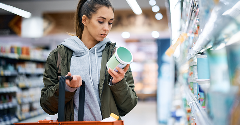News
Capri Sun adds monk fruit to US juice drinks to reduce sugar by 40%
15 Aug 2022With parents increasingly focusing on reducing their children’s sugar intake, Kraft Heinz is using monk fruit to cut sugar in US Capri Sun products to deliver on both taste and health credentials.
The impact of sugar and artificial sweeteners on the health of children has had much attention in recent years. Concerns around sugar consumption have prompted several US cities to adopt a 'soda tax'. This locally levied tax makes distributors of sugar-sweetened drinks pay on the drinks they distribute within cities like Boulder, Philadelphia, Seattle and San Francisco. Recent updates made by the US Food and Drug Administration (FDA) now require manufacturers to list added sugars in grams and as a percent Daily Value (%DV) on nutrition fact labels. As a result, interest in natural sweeteners is growing and monk fruit is becoming a popular natural alternative for manufacturers, according to Mintel. Monk fruit is said to have a similar flavour to sugar but without the bitter aftertaste of stevia.

Capri Sun, a key brand under the Kraft Heinz Company, has spent a number of years perfecting this new reformulation.
“Reducing sugar is a key aspiration for Kraft Heinz and has been a long-time goal of Capri Sun. We heard from our consumers that sugar content is a pain point and did extensive testing to find a way to reduce the added sugar naturally while maintaining the great taste consumers and kids know and love,” said a Kraft Heinz spokesperson.
By August this year, each pouch of original juice drink in the US will include monk fruit concentrate and contain around 8g of total sugars and 5g of added sugar. Additionally, new packaging will highlight the sugar reduction in all original juice drinks. The sugar-reduced Capri Sun will be rolled out in the US only, said Kraft Heinz.
A costly natural sweetener
Monk fruit (also known as luo han guo) is part of the melon family and native to China. Its fruit pulp contains compounds called mogroside V which are around 250 times sweeter than table sugar (sucrose) making it a desirable ingredient for food and drink products linked to naturalness and health. However, its high cost compared to other natural sweeteners creates a barrier for growth. Currently, it is not approved in Europe and use is rare but slowly growing in the US, China, Australia, Mexico and Japan with only 1% of product launches using monk fruit as a sweetener ingredient between June 2020 – May 2021. In Canada, monk fruit extract is only approved as tabletop sweetener. Monk fruit juice concentrate however, the ingredient used in Capri Sun, is permitted due to its lower mogroside V content.
Linked to health, plant-based and free-from
Although the number of food and drink products containing monk fruit is relatively small, according to Mintel data, those already on the market tend to be linked to health and diet trends such as free-from and plant-based. The fruit itself has been shown to have antioxidative, liver-protective and glucose-lowering properties. In a 2020 study from the Journal of Dairy Science, researchers developed a yoghurt using monk fruit extract as a sweetener. They found it had similar microstructural properties to yoghurt sweetened with sugar and results indicated monk fruit extract could be used successfully as novel sweetener and a food antioxidant for functional yoghurt and related products.
Related news

Value is a top priority for today’s F&B consumers
3 Apr 2025
Research from global consultancy Hartman Group suggests there are six core values that brands must tap into to connect with consumers’ needs.
Read more
Future F&B flavours favour exploration and explosive taste profiles
25 Mar 2025
Exploration and experimentation will define the future of flavour, according to Mintel, as consumers seek out taste profiles and textures that offer an adventurous eating experience.
Read more
Global consumers enjoy food less and perceive it as less healthy
20 Mar 2025
Enjoyment of food and its perceived healthiness is dwindling among most global populations, according to findings from Gallup and Ando Foundation/Nissin Food Products.
Read more
Plans to abandon mandatory Nutri-Score labelling ‘would be a step back’
17 Mar 2025
Critics have slammed reports that mandatory Nutri-Score labelling is to be abandoned as “a step back” that puts citizens’ health at risk.
Read more
Coca-Cola enters the prebiotic soda category
12 Mar 2025
Coca-Cola is leaning into nostalgia and the growing popularity of “gut-healthy” sodas to launch a line of prebiotic sparkling beverages.
Read more
Is the price of a sustainable and healthy diet… unsustainable?
4 Mar 2025
Healthier foods are more than twice as expensive per calorie as less healthy foods, with healthier food increasing in price at twice the rate in the past two years.
Read more
Does calorie labelling lead to reduced consumption?
27 Feb 2025
Calorie labelling of food products leads to a small, but consistent, reduction in the number of calories consumed, a study suggests.
Read more
Brands, retailers, and countries remain divided over Nutri-Score labels
30 Jan 2025
Europe's supermarkets and manufacturers are far from aligned over a standarised approach to nutrition labelling. Some welcome the non-mandatory Nutri-Score labels with open arms, while others have “considerable concerns”.
Read more
EU Parliament passes stricter packaging rules
20 Jan 2025
The European Parliament voted to approve updates to the packaging and packaging waste regulation, including enforceable re-use targets, limits on certain single-use packaging types, and restrictions on the use of PFAS “forever chemicals”.
Read more
Louis Drefyus Company powers on in plant-based with BASF ingredients acquisition
17 Jan 2025
BASF has agreed to sell its food and health performance ingredients business to Louis Dreyfus Company (LDC).
Read more